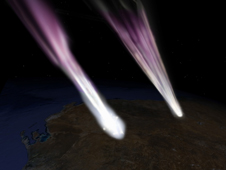Hayabusa Limps Home
If Hayabusa were a human explorer instead of a spacecraft, the first thing it might do on Sunday after returning to Earth from a seven-year voyage is pour a stiff drink.Japan’s first mission to an asteroid has generally been a success, and a major step up for the nation’s planetary program. But man…

If Hayabusa were a human explorer instead of a spacecraft, the first thing it might do on Sunday after returning to Earth from a seven-year voyage is pour a stiff drink.
Japan's first mission to an asteroid has generally been a success, and a major step up for the nation's planetary program. But man, did the spacecraft take a beating. Its thruster fuel is gone, the ion-drive engines are hanging by a thread, two of three reaction wheels that control the probe's attitude are kaput, the battery's dead (electricity now comes directly from the solar arrays), and, well, we're not 100 percent sure Hayabusa got the sample of dirt it tried to collect from asteroid Itokawa back in 2005.
We'll find out shortly after 9:51 a.m. Eastern U.S. time on Sunday, when the probe's sample return capsule is scheduled to come screaming into the atmosphere over the Woomera Prohibited Area, a desolate test range in southern Australia. NASA has dispatched an instrumented DC-8 to Australia to watch the fiery return, which, at 7.5 miles per second, matches the speed of a meteor.
Read about the Hayabusa mission on the project website, check here for updates, or watch this 21-minute JAXA video to get the story so far: